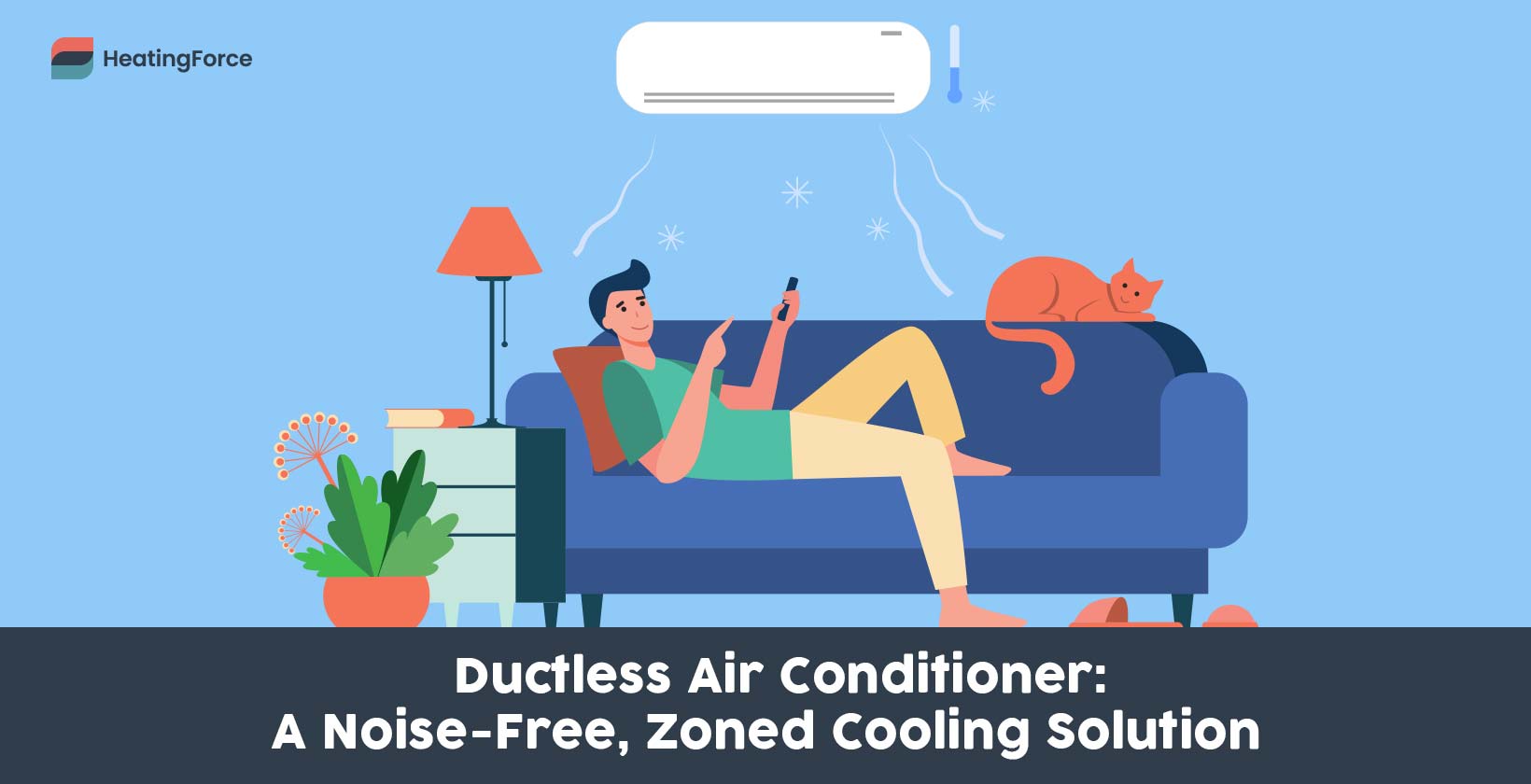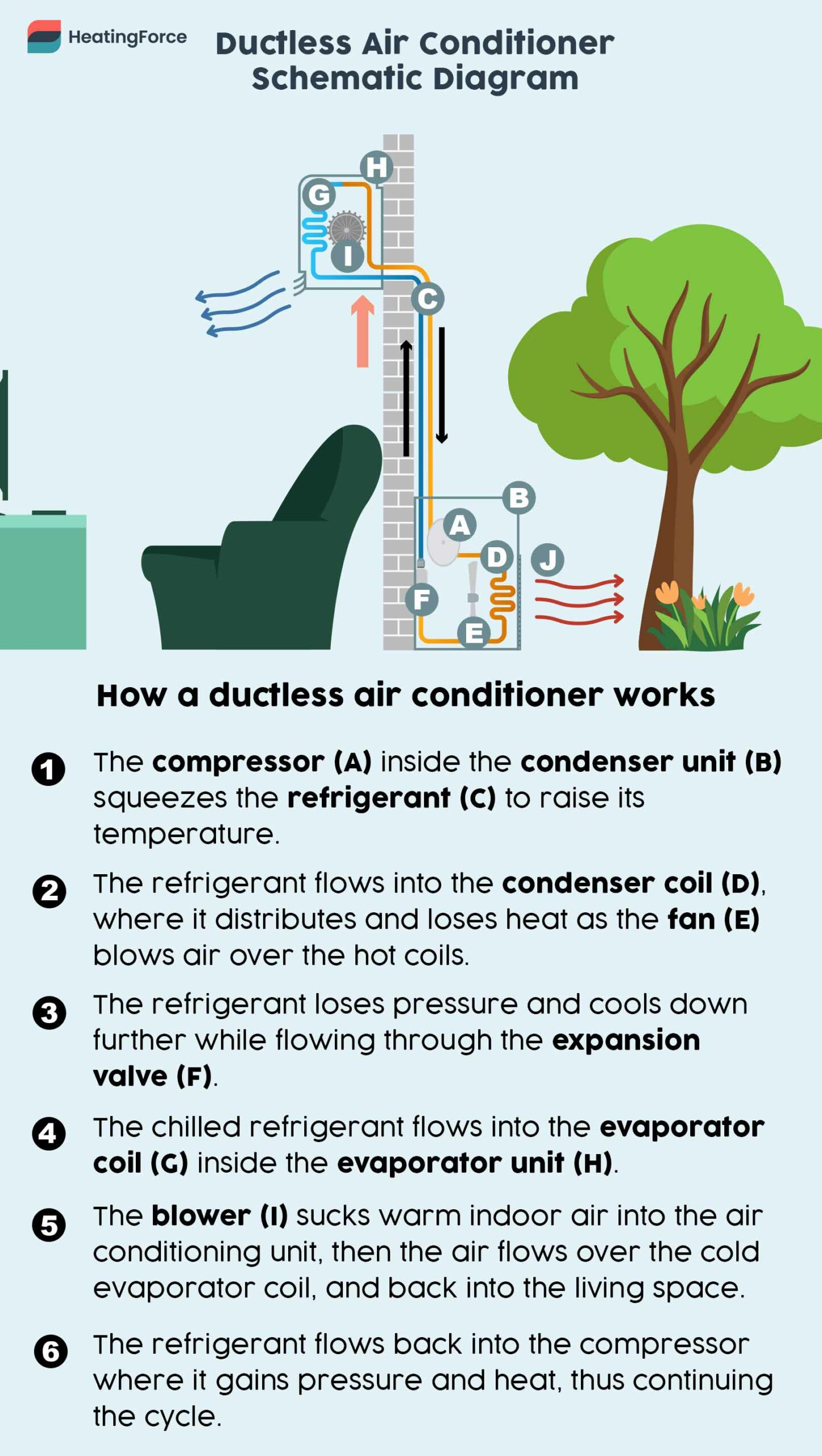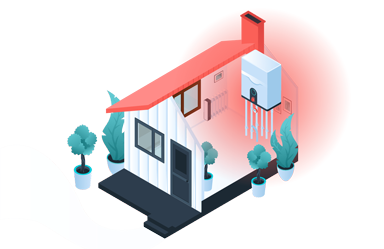Ductless Air Conditioner: Noise-Free, Zoned, Efficient Cooling Option
A ductless air conditioner (also known as a “mini-split”) is a quiet, energy-efficient cooling system that allows zone conditioning and is ideal for mid-sized homes. A ductless air conditioner’s main draw is that it does not require an inefficient, cumbersome air distribution network to be installed in the home. That said, its cooling capacity is similar to that of a ducted, central air unit.

Mini-split systems have an average capacity of 9,000-36,000 BTUs, which is comparable to the lower range of central air systems. This cooling power allows a ductless AC system to cool mid-sized homes with several rooms, as long as you’ve got an internal evaporator unit installed in each space that needs conditioned air.
A typical ductless mini-split costs around £2,000. The exact amount a ductless air conditioner costs depends on how large your home is and how many rooms the mini-split is meant to cool. That said, ductless ACs are still substantially less expensive than central air conditioners since their installation does not involve fitting an air distribution network. The installation is usually so straightforward that many homeowners choose to fit their ductless systems without professional assistance. However, in some cases, DIY installation may be dangerous, especially if you need to securely mount the heavy outdoor condenser units to the exterior wall of the house.
The cost of operating a ductless air conditioner varies widely depending on the unit’s capacity, your cooling patterns, and the electric unit rate. However, expect to pay around £65 per month on average to operate a mini-split system in a single room if you use the air-con for 6 hours every day.
The main advantage of ductless air conditioners is that there is no ductwork, and their operation is incredibly quiet. The biggest disadvantage is that a mini-split system costs well over a thousand pounds, and you require multiple evaporator units if you wish to cool more than a single space.
The most suitable alternative to a ductless air conditioner may include a central, window, or portable air conditioner, depending on your cooling needs.
What is a ductless air conditioner?
A ductless air conditioner (also known as a split-system air conditioner) is a type of air conditioner that comprises separate indoor and outdoor units with no ductwork between them. The indoor units contain the evaporator coils that cool the air, whilst the outdoor mechanism has the condenser coils that expel heat to the outside.
The indoor unit of a ductless air conditioner system is typically mounted high on the wall, from where it cools the room directly. Installation only requires a hole in the wall to snake in the wiring and refrigerant lines. As a result, ductless air conditioners have a much easier and more economical installation process than central air conditioners, which require ductwork. However, ductless air-con systems require the internal condenser unit to be installed in any room you wish to cool.
How does a ductless air conditioner work?
A ductless air conditioner works by transferring heat out of the space where the (internal) evaporator unit is installed. The evaporator coils chill the interior air by allowing the refrigerant that flows through them to absorb the heat. The refrigerant then travels to the (external) condenser unit via a copper tube, where it gains pressure and flows through the condenser coils, thus releasing the heat outdoors.

Can a ductless air-con cool a whole house?
Yes, a ductless air-con can cool a whole house, as long as you’ve got an internal elevator unit in each room. Such an air conditioning setup is referred to as a “multi-split” instead “mini-split”.
Mini-splits typically have a high cooling capacity of 9,000-36,000 BTUs, which is in theory enough to cool an entire house with several bedrooms. However, a single internal evaporator unit is only able to blow the chilled air into the space where it is installed. So, you require a separate evaporator unit in every room of your home if you wish to be able to cool the entire property. Luckily, a single condenser is able to serve as many as eight indoor evaporator units.
Do you need a ductless AC in every room?
Yes, you need a ductless AC in every room you wish to cool. However, each room does not require its own condenser. A single outdoor condenser is able to handle as many as eight indoor evaporators. So, most circumstances would entail getting one outdoor unit and an indoor unit in every room where you’d like to have air conditioning.
How much does a ductless air conditioner cost?
A ductless air conditioner unit costs around £2,000 on average, with installation included. However, the exact cost greatly depends on how large your home is and how many evaporators you want installed in your home. So, expect to pay between £800-£1,500 if you need to cool a single room, and as much as £3,500 or even more if you’re fitting the system to serve a larger home with several evaporators.
Keep in mind that the ductless air-con price ranges we provided above are just estimates. Factors beyond the unit’s cooling capacity often have a significant impact on the total cost of fitting a ductless air-con. Installation costs are a variable that’s notably unpredictable in the total cost of a mini-split system. It takes more time and effort to install a mini-split in a property with restricted access to the outdoors, or one that requires complex routing for the refrigerant lines. The longer installation times translate into higher labour and overall fitting costs. In contrast, simple setups, where the evaporator and condenser units are separated by a single wall, do not require a complex, expensive installation.
Can I install a ductless air conditioner by myself?
Yes, you can install a ductless air conditioner by yourself. A DIY mini-split installation roughly entails the following four steps.
- Set up the condenser: Start by setting up the condensing unit outside your home. Note that you need to use brackets or other adequate supports if you’re hanging the condenser on the exterior wall.
- Mount the evaporators: Hang the evaporator units in every room you wish to cool. The indoor units require mounting brackets and must be anchored to the wall’s structure, not just drywall.
- Install refrigerant lines: Set up the refrigerant lines that connect the condenser and evaporator units. This is an invasive procedure that entails puncturing the home’s envelope, so make sure you know how to perform this step properly.
- Connect the electrics: Follow the manufacturer’s instructions for connecting your mini-split system to mains electricity.
You should read the air-con manufacturer’s instructions to gauge if you’ve got the knowledge and equipment needed to install the system on your own. Note that some manufacturers may not honour their warranties if the mini-split is not installed by an HVAC professional.
How much does it cost to run a ductless air conditioner?
How much it costs to run a ductless air conditioner depends on how much power the unit consumes. For example, a typical 12,000 BTU mini-split uses 1kWh on average. This means that the unit consumes 1 kilowatt per hour of use. Given the average electric unit rate of 35p, we’re able to calculate the hourly running costs of a 12,000 BTU mini-split using the formula below:
1kWh x 1h x £0.35 = £0.35, i.e. 35p
In the 12,000 BTU mini-split example above, the hourly running costs are 35p. Operating this unit for six hours daily costs £2.10 per day and roughly £65 per month.
You’re able to calculate how much your preferred mini-split model costs to operate using the formula above, as long as you find out the power consumption in kWh. The unit’s kWh rating is usually stated on the packaging or in the literature provided by the manufacturer.
Are ductless air conditioners efficient?
Yes, ductless air conditioners are efficient, especially compared to central air conditioners. Ductless air conditioners are efficient because they do not rely on a network of ducts to circulate cold air throughout a home. The ducts allow the chill air to pick up heat as it travels, thus undermining the efficiency of the air conditioning unit. In fact, homeowners with a central air-con lose up to 25% of their energy within the ductwork. In contrast, mini-splits only circulate refrigerant between the indoors and outdoors, and this process does not lead to a loss of energy. Simply switching over to a mini split allows you to tuck 25% back into your wallet.
The efficiency of a ductless air conditioner is comparable to that of a portable and window air-con system since these AC types likewise do not rely on inefficient air distribution networks.
What are the advantages of ductless air conditioners?
Ductless air conditioners have four advantages. Firstly, ductless air-cons do not require an air distribution network to operate. Not having to install ductwork in your house means a cheaper, less invasive installation, less energy loss in the ducts, and no dust accumulation in the ductwork. Secondly, ductless ACs allow you to cool different zones in your home as needed. Zoned cooling is energy- and cost-efficient since you only cool the area you’re using at any given time. Thirdly, ductless air conditioner units are quiet. Most ductless air conditioner units are quieter than 30 decibels, which is quieter than the sound of a whisper. Other AC types are much louder than 19 decibels and regularly pull in 50-60 dB range decibel ratings. Fourthly, ductless air conditioners offer excellent value for the money. These ACs are able to keep an entire home cool with minimal loss of energy, yet they cost far less to install and operate than central air conditioning systems.
What are the disadvantages of ductless air conditioners?
Ductless air conditioners have two disadvantages. Firstly, ductless ACs are not cheap. You may not find that it’s worth it to spend over a thousand pounds on a mini-split system if your air conditioning needs are minimal. In contrast, you’re able to get away with a substantially less expensive portable air conditioner if you’re only cooling a small space during the hottest days of the year to prevent heat stroke. Secondly, you need an evaporator in every space you wish to cool. Ductless ACs are able to function with a single condenser unit outside, but you must hang an evaporator in any space that needs conditioned air. Consider a different air-con type if you’d prefer not to buy and hang multiple units or drill holes for the refrigerant lines into several walls.
Is a ductless air conditioner worth it?
A ductless air conditioner is worth it in the four circumstances listed below.
- You have a mid-sized property: Ductless air conditioners are a cost-effective cooling option for mid-seized properties with 2-3 bedrooms. However, you stand to save money by opting for a smaller, less expensive portable air conditioner if you’ve got a small flat. Conversely, consider getting a central air conditioner if you live in a large detached home with multiple spaces needing conditioning.
- You want the option to cool different zones: Ductless air conditioners allow you to cool multiple zones in your home, either separately or together, as needed. Central air conditioners are less efficient in this regard, since they drive the same volume of air up the home’s ducts, regardless of how many zones are being cooled at a given time. Meanwhile, portable ACs may be used to condition any space within your home, but with the added inconvenience of having to move the unit.
- You prefer a quiet air conditioner: Ductless ACs are generally quiet since the compressor is located in the outdoor unit. Most ductless air conditioners’ internal units operate at below 30 dB, which is equivalent to the sound of a whisper.
- You’d like to save on energy costs: Ductless air conditioners are a worthy investment if you’d like energy savings in the long term. These air conditioners are highly energy-efficient because they do not rely on ducted air distribution networks, which allow the chilled air to pick up the heat on the way to the registers.
How many zones can you have with a ductless air conditioner?
You can have up to five zones with a typical ductless air conditioner. The ability to condition five separate zones would entail having a single outdoor condenser unit and five indoor evaporators. However, some ductless AC condensers are capable of handling up to eight evaporator units, giving you the ability to condition eight zones within a single home.
Does a ductless air conditioner pull air from the outdoors?
No, a ductless air conditioner does not pull air in from the outdoors. Air conditioners (except dual-hose portable ACs) are fundamentally designed to chill and circulate indoor air. The only substance that a ductless air conditioner circulates between the indoors and the outdoors is the refrigerant, which is used to transfer the indoor heat outside.
Do ductless ACs filter air pollutants?
Yes, ductless AC units filter out air pollutants. Mini split systems come equipped with heavy-duty filters, much like the ones used in central air, window, and portable air conditioners. The filtering capabilities depend on what type of filter the AC is made with. Units that have High-Efficiency Particulate Air (HEPA) filters, for example, are able to remove over 99% of particles equal to 0.3 μm. The particulate matter that HEPA filters are able to remove from the air includes pollen, dust, various aerosols, and even pathogens such as viruses and bacteria. Be sure to check with the manufacturer to find out what filter type the ductless AC of your choice comes with, and what types of pollutants it’s able to remove from the air.
Does a ductless air conditioner need to be vented outdoors?
No, a ductless air conditioner does not need to be vented outdoors, since it does not remove hot air via convection. Ductless ACs do not circulate air from the indoors to the outdoors, but they do require an external unit that’s able to expel the heat from the refrigerant outdoors. In simple terms, a ductless air conditioner does not vent to the outdoors, but it requires an outdoor unit to expel heat.
Are ductless air conditioners loud?
No, ductless air conditioners are not loud. Most ductless mini-split systems only produce noise up to 30 decibels. The low levels of noise stem from the fact that a ductless AC compressor (its loudest component) is located outdoors, in the condenser unit, whilst the indoor units only contain a quiet fan or blower. In contrast, window and portable air conditioners tend to operate above 50db (significantly louder than a mini-split) because they house the compressor in a single unit.
What are the alternatives to mini-splits?
Below is a list of three alternatives to mini-splits.
- Central air conditioners: Central air conditioners are a powerful yet expensive alternative to mini-splits. Consider a central air conditioner if you’ve got a large home with multiple bedrooms, and you don’t mind doing the invasive work it takes to install an air distribution network.
- Window air conditioners: Window air conditioners are cheaper, but noisier and less powerful than ductless systems. Consider a window AC if you’re on a tight budget and have limited cooling needs.
- Portable air conditioners: Portable ACs are a budget alternative to their ductless counterparts. Consider a portable AC if you prefer to spend less upfront and do not mind moving the unit from one room to another.
